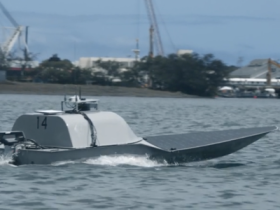HUNTSVILLE, Ala. — While the U.S. Army has exquisite firepower with its expensive long-range precision fire systems, it also wants to amass cheap rockets to target drones or overwhelm an enemy.
“If you’re familiar with the rocket pods we have for [guided multiple launch rocket systems], I would like to fill those rocket pods with 50 to 100 rockets,” Gen. James Rainey, Army Futures Command commander, said Tuesday at the Association of the U.S. Army’s Global Force Symposium in Huntsville, Alabama. “What we could put in that box … it’s not as good as [guided multiple launch rocket systems], but it can visit a lot of hate on the enemy in the right conditions.”
Rainey said the Army is engaging industry right now and is not just talking to companies that make rockets but industry that could disrupt manufacturing processes to build thousands of rockets or companies that can mass produce energetics, replacements for rocket motors or use additive manufacturing to produce rapidly.
The service is moving quickly, Rainey noted.
“We don’t have a few years,” he said, adding that the service has an emerging requirements document, which formalizes a new requirement and jumpstarts development. “We’re asking companies to mass produce — in the thousands — fires capabilities, counter-[unmanned aircraft systems] capabilities at a lower price point.”
Mass-producing rockets is one way to tackle the cost curve of countering drones, Maj. Gen. Frank Lozano, program executive officer for Missiles & Space, told Defense News in an interview at Redstone Arsenal outside Huntsville on Wednesday.
One way is to continue to refine electronic warfare technology. The other is to take out drones like the Iranian-developed Shahed loitering munition that costs over $5,000 a pop with cheap rocket systems. For example, the Army’s Hydra rocket costs roughly $45,000 per system.
“You’re finally getting to a one-on-one,” he said.
The service Program Executive Office Missile and Space is working with Army Development Command’s Aviation and Missile Center and the Long-Range Precision Fires Cross-Functional Team on direct support fires technology. The Army is looking to have a low-cost rocket that can be put into a multiple launch rocket system, or MLRS, family of munitions launcher, with 30 of those rockets with warheads that the service could mass “at a very high rate of fire” with a range in excess of 30 to 40 kilometers, Lozano said.
“We’re being very aggressive in that area to try to deliver capability so that whatever [large-scale combat operations] situation we find ourselves in, whether it’s [European Command] or Iranian or Korea fight, [Indo-Pacific Command] fight, we can give the warfighter this mass, high rate of fire capability that they need,” Lozano said.
The Army is taking a new look at its fiscal 2026 budget request and its five-year funding plan, but when funding is allocated, the hope is to make the effort a three- to five-year program, with more emphasis on three years because Army leadership wants rapid, aggressive action to deliver capability, according to Lozano.
Industry is already looking at how it can answer the call for large amounts of cheap rockets. While Lockheed Martin is developing the Joint Reduced Range Rocket for training to replace the legacy system it also builds, it is eyeing the potential to adapt the rocket for other missions.
“We’re definitely looking at [direct support fires technology] and how we could be a competitor in that market,” Dave Griser, vice president of guided multiple launch rocket systems at Lockheed Martin, told Defense News. “We think we can play there in terms of how we produce, our production and our experience that’s unique to [MLRS family of munitions] and what we do. We think it’s a good fit for us.”
The new five-inch rocket has a modular payload and the tubes can be reused and reloaded in the field, according to Griser.
The Army also recently chose Anduril Rocket Motor Systems to develop a new 4.75-inch solid rocket motor for long-range precision rocket artillery.
Jen Judson is an award-winning journalist covering land warfare for Defense News. She has also worked for Politico and Inside Defense. She holds a Master of Science degree in journalism from Boston University and a Bachelor of Arts degree from Kenyon College.
Read the full article here






Leave a Reply